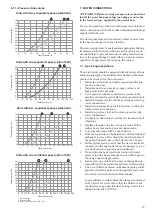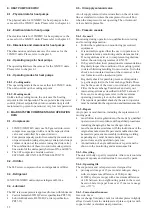
7
Ensure that you are using the correct refrigerant type
before recharging the unit.
Charging any refrigerant other than the original charge
type (R-134a) will impair machine operation and can even
lead to a destruction of the compressors. The compressors
operating with this refrigerant type are lubricated with a
synthetic polyolester oil.
RISK OF EXPLOSION
Never use air or a gas containing oxygen during leak tests to
purge lines or to pressurise a machine. Pressurised air
mixtures or gases containing oxygen can be the cause of
an explosion. Oxygen reacts violently with oil and grease.
Never exceed the specified maximum operating pressures.
Verify the allowable maximum high- and low-side test
pressures by checking the instructions in this manual and
the pressures given on the unit name plate.
Only use dry nitrogen for leak tests, possibly with an
appropriate tracer gas.
Do not unweld or flamecut the refrigerant lines or any
refrigerant circuit component until all refrigerant (liquid
and vapour) has been removed from unit. Traces of vapour
should be displaced with dry air nitrogen. Refrigerant in
contact with an open flame produces toxic gases.
The necessary protection equipment must be available,
and appropriate fire extinguishers for the system and the
refrigerant type used must be within easy reach.
Do not siphon refrigerant.
Avoid contact with liquid refrigerant on the skin or
splashing it into the eyes. Use safety goggles and gloves.
Wash any spills from the skin with soap and water. If liquid
refrigerant enters the eyes, immediately and abundantly
flush the eyes with water and consult a doctor.
The accidental releases of the refrigerant, due to small
leaks or significant discharges following the rupture of a
pipe or an unexpected release from a relief valve, can
cause frostbites and burns to personnel exposed. Do not
ignore such injuries. Installers, owners and especially
service engineers for these units must:
- Seek medical attention before treating such injuries.
- Have access to a first-aid kit, especially for treating
eye injuries.
We recommend to apply standard EN 378-3 Annex 3.
Never apply an open flame or live steam to a refrigerant
container. Dangerous overpressure can result. If it is
necessary to heat refrigerant, use only warm water.
During refrigerant removal and storage operations follow
applicable regulations. These regulations, permitting
condi-tioning and recovery of halogenated hydrocarbons
under optimum quality conditions for the products and
optimum safety conditions for people, property and the
environment are described in standard NF E29-795.
At least once a year thoroughly inspect the protection
devices (valves, pressure switches). If the machine operates
in a corrosive environment, inspect the protection devices
more frequently.
Regularly carry out leak tests and immediately repair
any leaks.
Ensure regularly that the vibration levels remain accep-
table and close to those at the initial unit start-up.
Before opening a refrigerant circuit, purge and consult the
pressure gauges.
Change the refrigerant when there are equipment failures,
following a procedure as the one described in NF E29-795
or carry out a refrigerant analysis in a specialist laboratory.
If the refrigerant circuit remains open for longer than a day
after an intervention (such as a component replacement),
the openings must be plugged and the circuit must be
charged with nitrogen (inertia principle). The objective is
to prevent penetration of atmospheric humidity and the
resulting corrosion on the internal walls and on non-
protected steel surfaces.
1.4 - Repair safety considerations
It is compulsory to wear personal protection equipment.
The insulation must be removed and warming up must be
limited by using a wet cloth.
Before opening the unit always ensure that the circuit has
been purged.
If work on the evaporator is required, ensure that the piping
from the compressor is no longer pressurised (as the valve
is not leaktight in the compressor direction.)
All installation parts must be maintained by the personnel in
charge, in order to avoid material deterioration and injuries
to people. Faults and leaks must be repaired immediately.
The authorized technician must have the responsibility to
repair the fault immediately. Each time repairs have been
carried out to the unit, the operation of the protection devices
must be re-checked.
Comply with the regulations and recommendations in unit
and HVAC installation safety standards, such as: EN 378,
ISO 5149, etc.
If a leak occurs or if the refrigerant becomes contaminated
(e.g. by a short circuit in a motor) remove the complete
charge using a recovery unit and store the refrigerant in
mobile containers.
Repair the leak detected and recharge the circuit with the
total R-134a charge, as indicated on the unit name plate.
Certain parts of the circuit can be isolated. Only charge
liquid refrigerant R-134a at the liquid line.








































